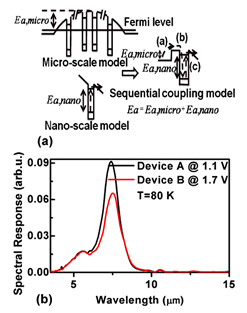Researchers of National Laboratory of Infrared Physics, Shanghai Institute of Technical Physics, Chinese Academy of Sciences have proposed a sequencial coupling transport mechanism for the dark current between the nanoscale and the micoscale processes by investingating the dark current characterisitcis and temperature dependence of quantum dot infrared photodetectors (QDIP).
They compare the dark current activation energies between two samples with identical structure of the dots-in-well in nanoscale but different microscale n-i-n environments and find that both the micro- and nanoscale activation energies (Ea, micro andEa, nano) contribute to the dark current activation energy Eain additive mode. The thermal emission in microscale structure and thermally assisted tunneling in nanoscale structure are present in the same device. These two mechanisms are coupled with each other in a sequential manner.

FIG. 1. (Color online) (a) Schematic diagram of the dark current activation energy mechanisms: microscale model, nanoscale model, and sequential coupling model. (b) Spectral response at 1.1 V for device A and 1.7 V for device B at 80 K.
This sequential coupling model will be helpful to optimize the QDIP performance, because the QDIP has shown its multiscale behavior.
The result has been published in Appl.Phys.Lett. 97,193511 (2010).